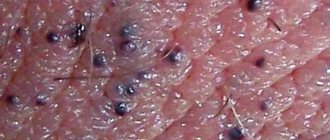Perineal varicose veins are varicose veins in the perineal area (varicose veins of the labia, varicose veins of the perineum), developing due to obstruction of venous outflow. Varicose veins of the labia are a manifestation of impaired outflow through the system of internal iliac veins due to their blockage or compression. The mere presence of signs of varicose veins of the labia does not pose a threat to the patient’s life, but is aesthetically unacceptable for young women, complicates sexual life and may indicate serious circulatory disorders in the pelvis.
Predisposing factors in the development of genital varicose veins in women
Varicose veins on the labia have a genetic predisposition - the mechanism of the disease is similar to varicose veins of the lower extremities. The basis is dysfunction of the valves of the gonadal veins. Physical activity, frequent pregnancies, engorgement of the genital organs during prolonged sexual intercourse contribute to vascular stretching with the development of venous stagnation. The appearance of varicose veins of the labia during pregnancy usually occurs in the second trimester and reaches a maximum closer to childbirth. After childbirth, these varicose veins, which developed during pregnancy on the labia, most often regress, but sometimes remain for life due to changes in the structure of the vascular walls.
Visual cues
Small Nabothian cysts can be seen only with the help of colposcopy, which allows you to examine the cervix in detail under magnification. They can also be described in the ultrasound report if it was performed transvaginally.
With extended colposcopy, the doctor sees changes on the cervix:
- small cystic formations from a couple of millimeters to a couple of centimeters;
- as a rule, several cysts are immediately noticeable on the neck; they can be located in groups, resembling a rash;
- the tubercles have a white-yellow tint due to the contents or are completely transparent.
Treatment of nabothian cysts is not required for small sizes, because they do not harm the woman. But since they are not prone to self-resolution and often grow, periodic colposcopy is required to monitor the dynamics. If the cyst grows and interferes with the outflow of menstrual blood, it can be easily removed using modern methods, such as radio wave therapy, cryotherapy or laser. All these treatments are available at Dr. AkNer. The procedure takes only a few minutes, does not cause pain, and does not require hospitalization. The cyst shell is damaged to evacuate the contents, then the surface is treated to avoid infection.
Arteriovenous compression
- Aorto-mesenteric compression of the left renal vein
Aorto-mesenteric compression of the left renal vein (aorto-mesenteric “tweezers”, nutcracker syndrome, mesoaortic compression syndrome of the left renal vein) is a situation in which the left renal vein is compressed between the aorta and the superior mesenteric artery. This leads to disturbances in the outflow of blood in the left renal vein, expansion and formation of “reverse” blood flow through the left gonadal vein with the formation of symptoms of varicose veins of the female genital organs.
- May-Turner syndrome
May-Turner syndrome is a situation in which the left common iliac vein is compressed by the right common iliac artery, leading to expansion of the common iliac vein below the site of compression and overflow of the pelvic vessels with venous blood. We also often observe the development of varicose veins - expansion of the left lower limb, the formation of persistent swelling of the soft tissues of the left lower limb and even trophic disorders (pigmentation). Most often, with May-Turner syndrome, varicose veins on the outer labia develop during pregnancy and remain forever after pregnancy (photo).
- Postthrombotic disease
Quite often one can observe the development of pelvic varicose veins in patients who have previously suffered deep vein thrombosis (especially proximal thrombosis) when there is a residual narrowing of the lumen or complete occlusion of the lumen of the common iliac vein. In this case, the outflow of blood from the pelvic organs is sharply hampered and, as a consequence, the expansion of the lumen of blood vessels and the development of pelvic varicose veins.
- Venous dysplasia
This is a malformation of the superficial or deep veins that occurs in the early phases of the formation of the vascular system of the embryo in the period from 4 to 8 weeks of intrauterine development. Venous dysplasia leads to the appearance of varicose veins of the minor lips. The diagnosis of dysplasia can be established provided that other causes of dilation of the genital vessels are excluded. Dysplasias look like dense vascular spots that are difficult to empty when squeezed. They resemble tumor-like formations more than dilated varicose veins.
Symptoms of nabothian cysts
When they are small, they are not able to lead to the formation of any symptoms. But as they increase in size, Nabothian cysts can alter the menstrual process, preventing the passage of natural blood discharge. Also, in rare cases, large Nabothian cysts can interfere with conception.
For some women, the amount of daily discharge may increase significantly and there will be more mucus in it. But this symptom is common to many other conditions, so it is often not a cause for concern. If such a large cyst bursts, the woman will definitely notice heavy discharge that exceeds the standard.
Symptoms and complaints of perineal varicose veins
In the classic version, there is a triad of symptoms:
- Pelvic pain.
- Varicose veins of the labia and perineum.
- Dysmenorrhea is a cyclical process, when during menstruation severe pain in the lower abdomen, heavy menstrual bleeding, and menstrual irregularities may appear.
- With a long course of the disease, the development of dyspareunia is possible - painful sensations in the lower abdomen that occur during or after sexual intercourse. A peculiarity of this symptom is the persistence of pain for at least 30 minutes and up to a day after sexual intercourse.
Causes of bloody pimples on the labia
There are several other conditions and factors that can lead to bumps similar to vaginal blood pimples, which include:
Sexually transmitted infections (STIs)
Lumps and pimples on the labia can be caused by sexually transmitted infections such as genital warts and genital herpes.
Two common sexually transmitted infections can cause bloody pimples around the vagina: genital warts and genital herpes:
- Genital warts: small, firm clumps, they may resemble a red cauliflower in appearance. They are more common in women and are caused by the human papillomavirus (HPV). Women may consider the HPV vaccine before they become sexually active as a treatment for these bloody pimples. to help prevent genital warts.
- Genital herpes: Caused by the herpes simplex virus (HSV), genital herpes can result in painful or itchy patches and, in the final stages, bloody large pimples on the labia or groin. Because the virus may lie dormant in the body, genital herpes can be contagious even if no visible spots or sores Like genital warts, the virus cannot be cleared from the body once it appears However, medication can reduce symptoms, outbreaks, and reduce the risk of transmitting the virus to sexual partners Using condoms can reduce the chance of partner A getting genital herpes if he does detection, treatment is possible only for preventive purposes and to remove the consequences of its presence, and not to completely get rid of the infection inside the body.
Disease prognosis
Varicose veins of the uterus and perineum are not a life-threatening disease. But it is important to note that the quality of life of patients is significantly reduced. In addition to aesthetic discomfort, large perineal phleboectasis can cause painful symptoms during menstruation and complicate sexual life. Sometimes varicose veins become inflamed, causing a lot of physical suffering to patients. You should not count on the therapeutic effect of ointments and tablets - such therapy is not effective, but only eliminating the causes of varicose veins and the venous nodes themselves using sclerotherapy or miniphlebectomy allows one to achieve excellent therapeutic and aesthetic results in all patients. At the Innovative Vascular Center, complete treatment of this disease is possible. We successfully perform endovascular correction of deep vein pathology, eliminate varicose veins of the small pelvis and venous vessels on the genitals.
Bloody pimples in intimate places on the pubis and groin: causes
Poll: When did your acne appear? (Number of votes: 4295)
I've been suffering all my life
It's been a couple of years now
About a few months
Recently
To vote, click on the desired answer. results
It's not always clear what causes vaginal acne. However, some of the most common causes include:
Contact dermatitis
Vaginal acne is similar to other acne found on the body and the causes vary.
Contact dermatitis is a type of eczema caused by skin contact with an allergen or irritant. Many cases of vaginal acne are contact dermatitis in the genital area.
Common irritants and allergens that contribute to vaginal acne include:
- souls;
- feminine hygiene products such as lotions, powders and deodorants;
- scented soaps and shower cleansers;
- washing powders;
- medicated lotions or gels;
- personal lubricants, spermicides or condoms;
- sweating;
- sanitary pads or tampons, especially scented ones;
- sperm;
- urine.
Folliculitis
Another very common cause of bloody pimples on the labia and pubic area is folliculitis, which is an infection and inflammation of the hair follicles.
A follicle is a small cavity in the skin from which hair grows, and each hair on the body grows from its own follicle. Red blood acne in this disease appears in the form of small inflammations.
Folliculitis may result from:
- irritation after shaving;
- ingrown hair;
- wearing tight clothes or underwear that rub off the skin;
- follicles that are blocked or irritated by sweat glands not working properly or reactions to hygiene products not intended for use in intimate areas;
- swimming in the dirty water of a river, pool or even a bath.
- A bloody pimple can appear after an infected cut or wound, perhaps from shaving, which allows bacteria to spread to nearby hair follicles
Acne Inverse
Also called hidradenitis suppurativa, acneinitis is a chronic inflammatory skin disease that affects the sweat glands in the groin, pubic area and under the breasts.
Acne inversion is characterized by recurring spots and sores that contain pus, and in more severely inflamed cases, they can include bloody pimples with pus. They do not heal easily and can leave scars. According to the Hidradenitis Suppurativa Foundation, this disease affects up to 4 percent of the population at different times.
Coconut oil is a powerful natural remedy for long-lasting acne!
Molluscum contragiosum
Molluscum virus contagiosity is a viral infection characterized by lesions that can occur anywhere on the body, including the genital area of the labia, pubis, and groin.
The volume of such a blood pimple, called a molluscum, is usually small, but quite dangerous, so you should not delay its treatment and should immediately seek help from your doctor.
Complications of hidradenitis on the labia
Treatment of hidradenitis at any stage in our clinic is usually highly effective.
If timely and adequate treatment is not carried out, hidradenitis on the labia can lead to a number of complications:
- If the abscess cavity is not opened in a timely manner, the pus may spread deep into the tissues. An abscess of the soft tissues of the genital organs develops.
- Decreased immunity and the presence of severe concomitant diseases can lead to the development of an abscess or phlegmon in the pelvic cavity.
- Penetration of a pyogenic infection into the bloodstream can cause the development of thrombosis of the veins of the lower extremities, iliac veins and pelvic veins.
- In severe cases, when the pathological process is at an advanced stage and against the background of severe immunodeficiency, sepsis and infectious-toxic shock can develop.
Diagnosis of the disease is usually made on the basis of clinical data. If you seek medical help in a timely manner, the prognosis of the disease is usually quite favorable.
Diagnostic methods in surgery:
- Doppler in surgery
- Colonoscopy
- Angiography
- CT scan
- Gastroscopy
- MRI
- Abdominal ultrasound
- X-ray
- Endoscopy
Prices:
| Code | Name of service | Prices |
| 1 | Initial appointment | 1200 |
| 2 | Repeated appointment | 900 |
| 3 | Calling a surgeon to your home | 3500 |
| 4 | Abdominal ultrasound | 2200 |
| 5 | Ultrasound of veins and vessels | 2400 |
| 6 | Doppler 2-3 trimester | 1200 |
| 7 | Rectoscopy | 1500 |








